Related Research Articles

Alfonso III, called the Great, was the king of León, Galicia and Asturias from 866 until his death. He was the son and successor of Ordoño I. In later sources he is the earliest to be called "Emperor of Spain." He was also titled "Prince of all Galicia".
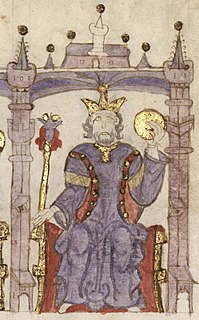
Alfonso IV, called the Monk, was King of León from 925 and King of Galicia from 929, until he abdicated in 931.
Ramiro I was king of Asturias from 842 until his death in 850. Son of King Bermudo I, he became king following a succession struggle after his predecessor, Alfonso II, died without children. During his turbulent reign, he fended off attacks from both Vikings and Moors. Architecturally, his recreational palace Santa María del Naranco and other buildings used the ramirense style that prefigured Romanesque architecture.

García Íñiguez I, also known as García I was the second king of Pamplona from 851–2 until his death. He was the son of Íñigo Arista, the first king of Pamplona. Educated in Cordoba, he was a successful military leader who led the military campaigns of the kingdom during the last years of his father's life.
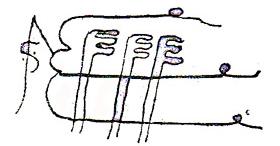
García I was the King of León from 910 until his death and eldest of three succeeding sons of Alfonso III the Great by his wife Jimena.

Ordoño II was a king of Galicia from 910, and king of Galicia and León from 914 until his death. He was an energetic ruler who submitted the kingdom of Leon to his control and fought successfully against the Muslims, who still dominated most of the Iberian Peninsula. His reign marked the tactical and smooth transition of the regnum Asturum to the regnum Legionis, with the royal headquarters already established in the city of León.
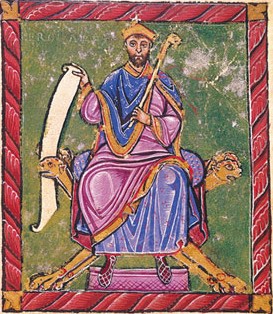
Fruela II was the King of Asturias from the death of his father, Alfonso III of Asturias, in 910 to his own death. When his father died, the kingdom was divided, with the third son, Fruela, taking the original portion (Asturias); the second, Ordoño, taking Galicia; and the eldest, García, taking León. As king of Asturias, he had the job of consolidating the region later called Castile and keeping its counts in check.

Alfonso Fróilaz, called the Hunchback, was briefly the king of the unified kingdom of Asturias, Galicia and León in 925. He succeeded his father, King Fruela II, in July 925 but was driven from the throne within the year by his cousins Sancho, Alfonso IV and Ramiro II, the sons of his uncle, Ordoño II. He was restored to a royal position in part of the kingdom after Alfonso IV took power in 926, but was violently deposed and forced into a monastery in 932.

Ordoño IV, called the Wicked or the Bad was the king of León from 958 until 960, interrupting the reign of Sancho the Fat for a two-year period.
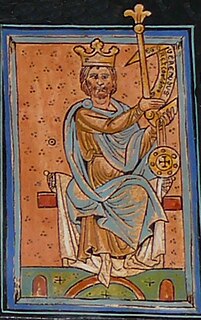
BermudoII, called the Gouty, was first a rival king in Galicia (982–984) and then king of the entire Kingdom of León (984–999). His reign is summed up by Justo Pérez de Urbel's description of him as "the poor king tormented in life by the sword of Almanzor and in death by the vengeful pen of a bishop," Pelagius of Oviedo, half of whose Chronicon covers the reign of Bermudo and is highly critical of the king. He accuses Bermudo of imprisoning Bishop Gudesteus of Oviedo in the 990s and blames the attacks of Almanzor on Bermudo's sins.
Ruderick, better known by his Spanish name Rodrigo, was an influential noble of the Kingdom of Asturias, and was probably the first Count of Castile (850/862–873) and Álava (867/868–870). He was an active participant in the Reconquista and a faithful vassal of Ordoño I and Alfonso the Great, kings of Asturias. By conquering land from the Moors, Rodrigo began the southern expansion of the County of Castile.
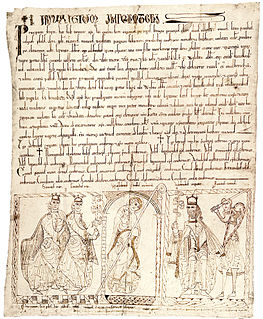
Imperator totius Hispaniae is a Latin title meaning "Emperor of All Spain". In Spain in the Middle Ages, the title "emperor" was used under a variety of circumstances from the ninth century onwards, but its usage peaked, as a formal and practical title, between 1086 and 1157. It was primarily used by the kings of León and Castile, but it also found currency in the Kingdom of Navarre and was employed by the counts of Castile and at least one duke of Galicia. It signalled at various points the king's equality with the rulers of the Byzantine Empire and Holy Roman Empire, his rule by conquest or military superiority, his rule over several ethnic or religious groups, and his claim to suzerainty over the other kings of the peninsula, both Christian and Muslim. The use of the imperial title received scant recognition outside of Spain and it had become largely forgotten by the thirteenth century.

Sampiro was a Leonese cleric, politician, and intellectual, one of the earliest chroniclers of post-conquest Spain known by name. He was also the Bishop of Astorga from 1034 or 1035 until his death.
The Battle of Valdejunquera took place in a valley called Iuncaria on 26 July 920 between the Islamic emirate of Córdoba and the Christian armies of the kingdoms of León and Navarre. The battle, a victory for the Córdobans, was part of the "campaign of Muez", which was directed primarily against León's southern line of defence, the county of Castile along the Duero river.
Fernando Ansúrez I was the Count of Castile in 929 and the earliest known member of the Beni Ansúrez family; his father, Ansur, is known only through his patronymic. He was also count of the Tierra de Campos, which was later formed into the County of Monzón for his son.
Oveco was the Bishop of Oviedo from 913/4, whose episcopate lasted almost half a century. Despite his longevity he is a relatively obscure figure. His origins lie in the same landed and wealthy aristocratic family as those of the Count Piniolo (Piñolo) who founded the monastery of San Juan Bautista de Corias. While the city of Oviedo and its diocese were overshadowed at the time of Oveco's election, at the height of his career, during the turbulent reign of Ramiro II, he was the senior bishop of the realm and his city was labelled the sedem regum.

Fruela de Cantabria or Fruela Pérez was the second son of Duke Peter of Cantabria and brother of King Alfonso I of Asturias.
Froila Arias was a Galician count who governed the fortress of Traba and the region of Trastámara during a tumultuous period.
Eylo or Gilo is the first attested count of Álava. He is known from the chronicle of Sampiro, written in the first third of the eleventh century, which presents him as a rebellious subject of the Kingdom of Asturias, strongly suggesting that he was not appointed count by the king but was instead the leader of a rebellion. After King Alfonso III marched an army into Álava, the people submitted and Eylo was taken into captivity and brought back to Alfonso's capital of Oviedo.
References
- Notes
- 1 2 3 4 5 Collins 2012, pp. 76–77, 116.
- ↑ Martínez Díez 1993, p. 116: in presentia domini Froilani commiti ... Froila quas iudicaui.
- 1 2 Martínez Díez 2005, p. 159.
- 1 2 Portela 2015, p. 371.
- ↑ Carriedo Tejedo 1993–94, p. 145.
- ↑ Carriedo Tejedo 1993–94, p. 136, n. 302: villa vocitata Carracia, quam ille infoelix Froila, dum erat de ratione ecclesie Hiriense sedis et Sancte Eulalie sibi aprehendiderat.
- ↑ Martínez Díez 2005, p. 136.
- ↑ Wolf 2012, p. 70.
- ↑ Martin 2011, para. 16, n. 53.
- 1 2 Martínez Díez 2005, p. 220.
- ↑ Carriedo Tejedo 1993–94, p. 130: Adefonsus filius domini Ordonii successit in regnum. . . In ingressione regni annos gerens etatis xiiii, filius quidem perditionis Froyla Iemundi (or Lemundi) ex partibus Gallece venit, ad inquirendum regnum sibi non debitum. Rex vero Adefonsus hoc audiens, seccessit in partibus Alavensium.
- ↑ Gómez-Moreno 1921, p. 96: "Alfonso, hijo de D. Ordoño, sucedió en el reino. Este fué belicoso, y en todos los empleos bien ejercitado. A su entrada en el reino, teniendo catorce años de edad, un hijo de perdición, ciertamente, Fruela Jemúndez, desde las comarcas de Galicia vino a pretender el reino, que no le correspondía. Mas el rey Alfonso, en oyendo esto, retiróse a las comarcas de los alaveses. Mas el propio nefando Fruela fué muerto por la nobleza ovetense. Esto oyendo el rey, volvió a los suyos y gustosamente fué recibido."
- ↑ Carriedo Tejedo 1993–94, p. 132: Iste primo regni sui anno, et nativitatis decimo quarto ab apostata Fruvilano Gallecie comite per tyrannidem regno privatur.
- Bibliography
- Carriedo Tejedo, Manuel (1993–94). "Nacimiento, matrimonio y muerte de Alfonso III el Magno" (PDF). Asturiensia Medievalia. 7: 129–45.
- Collins, Roger (2012). Caliphs and Kings: Spain, 796–1031. London: Wiley Blackwell.
- Gómez-Moreno, Manuel (1921). Introducción a la Historia silense, con versión castellana de la misma y de la Crónica de Sampiro. Madrid.
- Martin, Georges (2011). "Linaje y legitimidad en la historiografía regia hispana de los siglos IX al XIII". E-Spania. 11. Retrieved 28 February 2017.
- Martínez Díez, Gonzalo (1993). "Los condados altomedievales: Castilla, Monzón y Carrión". Repoblación y reconquista: Actas del III Curso de Cultura Medieval, Aguilar de Campoo, septiembre de 1991. Fundación Santa María la Real Centro de Estudios del Románico. pp. 115–26. ISBN 84-600-8664-X.
- Martínez Díez, Gonzalo (2005). El Condado de Castilla (711–1038): La historia frente a la leyenda. Valladolid: Junta de Castilla y León. ISBN 84-9718-275-8.
- Portela, Ermelindo (2015). "The Making of Galicia in Feudal Spain (1065–1157)". In James D'Emilio (ed.). Culture and Society in Medieval Galicia: A Cultural Crossroads at the Edge of Europe. Leiden: Brill. pp. 367–99.
- Wolf, Kenneth Baxter (2012). "The Kings of Asturias: Chronicle of Albelda". In Constable, Olivia Remie; Zurro, Damian (eds.). Medieval Iberia: Readings from Christian, Muslim, and Jewish Sources (2nd ed.). Philadelphia: University of Pennsylvania Press. pp. 67–74.